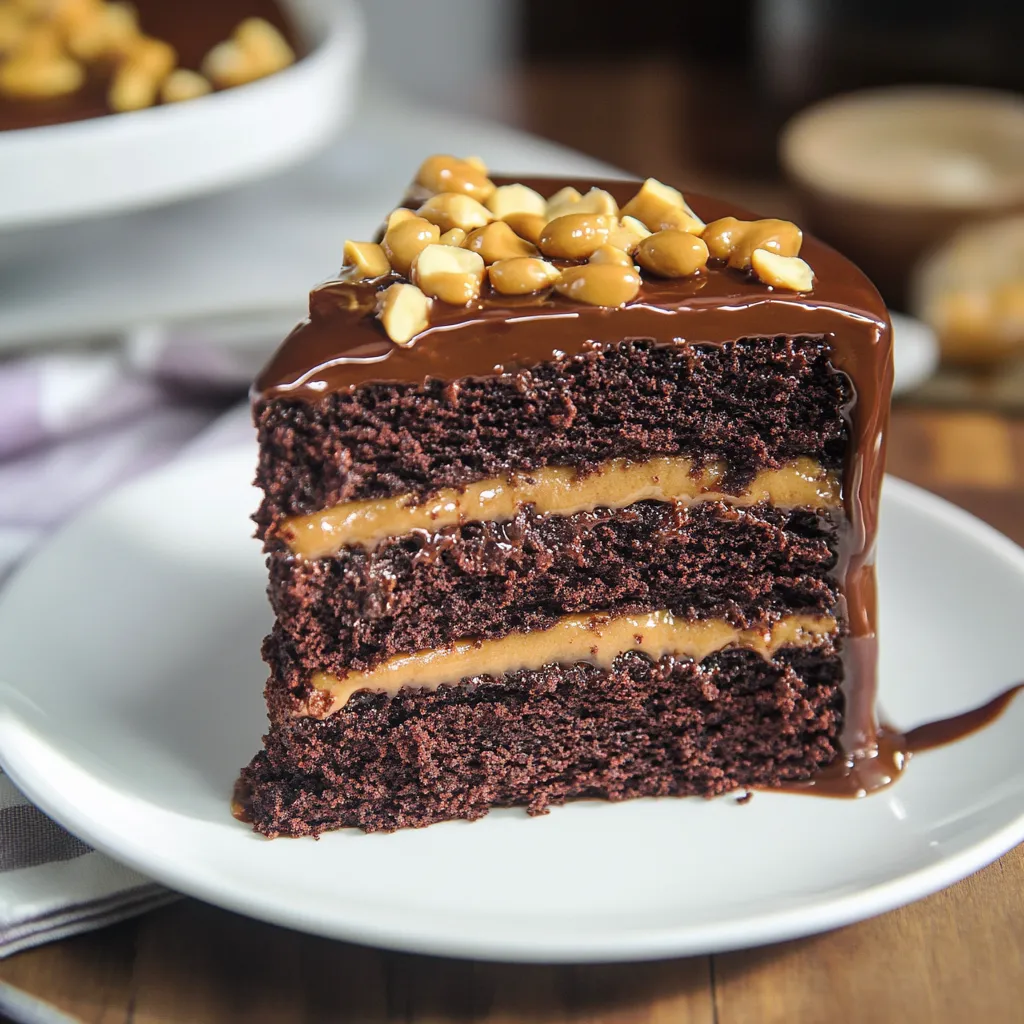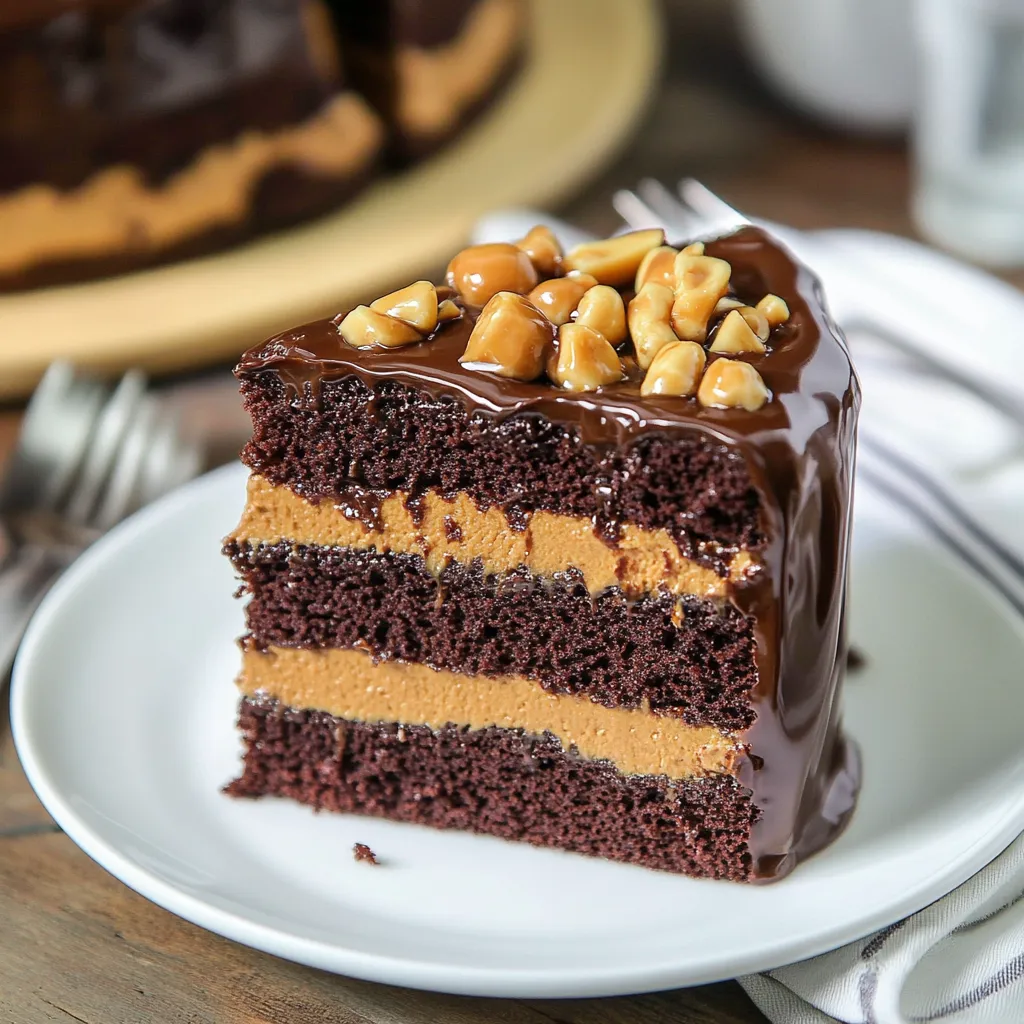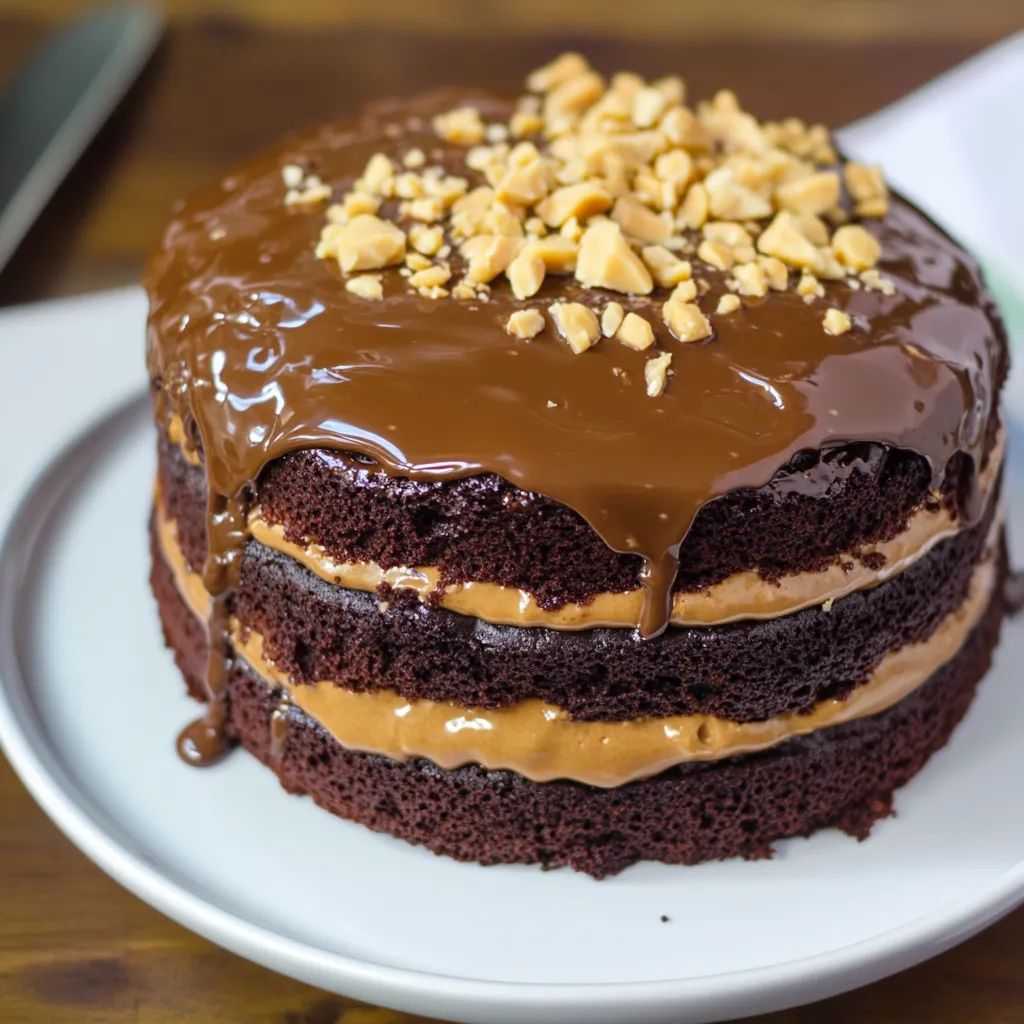 Pin it
Pin it
Picture a luxurious chocolate cake stacked with velvety ganache and homemade salty peanut caramel - it's the type of sweet treat that sticks in your mind forever. Rich chocolate flavors paired with sticky caramel and crunchy peanuts turn an ordinary cake into something truly remarkable. When I first crafted this method, I wanted something worthy of your biggest life moments that any home baker could pull off.
I've baked this cake over and over for family parties and special days. What I love most is watching everyone's expression when they take that first bite with all the flavors coming together.
Key Ingredients Breakdown:
- Cocoa Powder: Go for Dutch-processed for a deeper, more intense chocolate flavor and darker look
- Sour Cream: Don't skip the full-fat version - it keeps everything moist and helps the baking soda work its magic
- Milk Chocolate: Buy good quality bars instead of chips for the smoothest possible ganache
- Heavy Cream: Pick one with at least 36% fat to get the right texture in your caramel and ganache
- Roasted Peanuts: Get the salted kind for that perfect crunch and flavor boost in the caramel
Step-By-Step Baking Guide:
- 1. Setting Up Before You Start
- - Get everything out 30 minutes early so it's room temperature
- Put parchment circles in your cake pans and grease the sides well
- Make sure your oven rack sits in the middle for even heat - 2. Mixing Your Cake Batter
- - Stir the cocoa and boiling water until smooth - this wakes up the chocolate flavor
- Mix all dry stuff thoroughly so nothing clumps
- Slowly add wet ingredients and mix each time until they disappear
- Split batter between pans, weighing them if you can for even layers - 3. Creating Silky Ganache
- - Cut chocolate into same-sized pieces so it melts evenly
- Warm cream just until tiny bubbles show up at the edges
- Don't touch it for 3 minutes after combining
- Stir from middle to outside until it looks glossy - 4. Making Perfect Caramel
- - Watch it like a hawk - the color changes fast
- Gently tip the pan instead of stirring to avoid sugar crystals
- Measure your cream beforehand so it's ready to go
- Step back when you add cream so the steam doesn't burn you - 5. Putting It All Together
- - Trim cake tops with a serrated knife so they look professional
- Cool layers in the fridge for 20 minutes to make handling easier
- Use a turntable if you have one for easier ganache spreading
- Keep a knife in warm water for smooth caramel drizzling
 Pin it
Pin it
My kids go crazy for the caramel sauce - we usually make extra just to pour over ice cream later. That sweet-salty mix always reminds me of making sticky caramel apples with my grandma.
Secrets To Incredible Moisture:
Keeping this cake moist comes down to getting the ingredients just right. Using oil with sour cream makes a tender cake that won't dry out for days. After trying this recipe countless times, I've found this mix gives you the perfect texture - sturdy enough for the ganache but still incredibly soft.
How To Cut It Beautifully:
There's nothing better than cutting into this cake and watching caramel slowly run down between layers. For the prettiest slices, I've learned to dunk my knife in hot water and wipe it clean between cuts. This simple trick gives you picture-perfect pieces every time.
How Flavors Change Over Time:
What's really cool about this cake is how the taste gets better with time. While it's yummy on the first day, it actually tastes best on day two after the caramel has slightly soaked into the layers and the ganache has set completely.
Baker's Smart Tricks:
- Start with the caramel sauce - if it doesn't work out, you can try again without wasting other stuff
- Pop the whole cake in the freezer for 15 minutes before the final ganache layer for cleaner edges
- Keep leftover slices standing up in a tall container so the layers don't squish together
After baking for many years, this recipe still makes me proud. It hits that sweet spot between wow-factor and doable, making it great for special occasions or just when you need a chocolate-caramel fix. The mix of textures and flavors creates something you won't forget - a cake that's just as fun to make as it is to eat.
Smart Chocolate Picking:
Every fantastic chocolate cake starts with picking the right chocolate. I've tried tons of brands and percentages for this recipe. Fancy chocolate works great, but medium-priced stuff is fine too. The trick is using chocolate you'd happily eat by itself. I've found that using different percentages - like 60% dark cocoa in the cake but milk chocolate in the ganache - gives you amazing flavor layers.
Getting Time And Temperature Right:
One thing that took me forever to figure out was how temperature affects each part of this cake. Your layers must be totally cold before you stack them - even slightly warm cake will melt your ganache. But the ganache itself needs just the right coolness - too warm and it drips everywhere, too cold and it won't spread. I now make the ganache while the cakes cool, so both reach the perfect temperature at the same time.
Sugar Know-How:
After making this countless times, I've learned that using both white and brown sugar isn't just about sweetness - it's about keeping moisture and building flavor. The molasses in brown sugar adds subtle caramel hints that work with the salted caramel, while helping the cake stay moist. That's why I never use all white sugar, even when I'm running low on brown.
Getting That Perfect Texture:
The feel of this cake is something I really love. The inside is firm enough to hold up all that ganache and caramel, but still soft and moist. This happens through careful mixing - too much mixing makes a tough cake, too little gives you uneven texture. I count my stirs while mixing to keep things consistent each time I make it.
 Pin it
Pin it
Baking At Different Heights:
Living in different places during my baking life taught me about adjusting recipes. When you're at higher elevations, using less baking powder and more liquid helps your cake stay together. I've made this cake successfully from sea level all the way up to 5,000 feet, tweaking things as needed.
Keeping It Fresh:
Storing this cake right is super important. While it stays good on your counter for several days, I've figured out ways to keep it longer. You can freeze individual slices with parchment paper between them, then let them thaw in the fridge overnight. Surprisingly, the ganache and caramel stay pretty much perfect this way.
Changing With The Seasons:
Throughout the year, I switch things up to match the season. In summer, I might put fresh raspberries between layers. During fall, I sometimes add bourbon to the caramel and use toasted pecans instead of peanuts. For winter holidays, a bit of peppermint in the ganache works beautifully, while spring calls for some orange zest to brighten the chocolate.
Fixing Common Problems:
After teaching this recipe to lots of people, I've seen almost every possible issue. If your caramel gets grainy, add a splash of hot water and gently reheat it. When ganache separates, warming it slightly while whisking hard usually fixes it. Even sunken cake centers can be saved by turning everything into a trifle with the same ganache and caramel.
Sharing The Love:
Maybe what makes this cake so special is how it brings folks together. I've taught this recipe in so many baking classes, and I love seeing how proud students feel when they make their first successful caramel. This cake has become the most requested dessert at family gatherings, with relatives claiming corner pieces weeks before parties.
Tools That Help:
You don't need fancy gear, but some things do make baking easier. Good cake pans that spread heat evenly make a big difference. I've found light-colored aluminum pans work best since dark ones can burn the edges too quickly. A candy thermometer takes the guesswork out of caramel making, though I've taught many people to judge it just by color.
Getting Everything Ready First:
One lesson I learned early on was how helpful it is to prep everything before starting. Having all ingredients measured and ready makes the whole process more fun and less stressful. This matters most with caramel sauce, since timing is crucial and you can't stop to measure things once the sugar starts changing color.
 Pin it
Pin it
Making It Uniquely Yours:
While this recipe works perfectly as written, I always tell bakers to add their own touch. Some students have thrown in espresso powder to boost the chocolate flavor, while others have tried different nuts in the caramel. These personal tweaks make the recipe more meaningful to everyone who tries it.
A Forever Favorite:
This cake has grown into more than just a recipe in my collection - it's become something special I've shared with my kids and countless students. It shows the perfect mix of technique and creativity, precision and flexibility. Each time I bake it, I think about all the celebrations it's been part of and all the happiness it's brought to those who've tasted it.
Frequently Asked Questions
- → Is it fine to prepare the layers early?
- Of course! Bake the layers a day before and put them together when you're ready.
- → Why does the caramel get thicker?
- As it cools, that’s normal. Just warm it gently to loosen it up.
- → Can I leave out the peanuts?
- Yep, just ditch the peanuts for a classic caramel option.
- → What’s the best way to store it?
- Pop it in the fridge covered for up to 5 days. Let it sit out a bit before digging in.
- → Can I swap milk chocolate for dark?
- Absolutely, switch to dark chocolate if you prefer a bolder taste.
